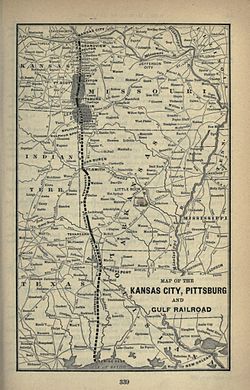
DeQuincy is the northernmost city in Calcasieu Parish, Louisiana, United States. The population was 3,235 at the 2010 census. DeQuincy is part of the Lake Charles metropolitan statistical area.

Rosepine is a town in Vernon Parish, Louisiana, United States. The population was 1,692 at the 2010 census. It is part of the Fort Johnson South Micropolitan Statistical Area.

The Kansas City Southern Railway Company was an American Class I railroad. Founded in 1887, it operates in 10 Midwestern and Southeastern U.S. states: Illinois, Missouri, Kansas, Oklahoma, Arkansas, Tennessee, Alabama, Mississippi, Louisiana and Texas. KCS owns the shortest north-south rail route between Kansas City, Missouri, and several key ports along the Gulf of Mexico.

Kansas City Southern (KCS) was a transportation holding company with railroad investments in the United States, Mexico, and Panama and operated from 1887 to 2023. The KCS rail network included about 7,299 miles (11,747 km) of track in the U.S. and Mexico.

The Missouri Pacific Railroad, commonly abbreviated as MoPac, was one of the first railroads in the United States west of the Mississippi River. MoPac was a Class I railroad growing from dozens of predecessors and mergers. In 1967, the railroad operated 9,041 miles of road and 13,318 miles of track, not including DK&S, NO&LC, T&P, and its subsidiaries C&EI and Missouri-Illinois.

The Louisiana and Arkansas Railway was a railroad that operated in the states of Arkansas, Louisiana, and Texas. The railroad's main line extended 332 miles, from Hope, Arkansas to Shreveport and New Orleans. Branch lines served Vidalia, Louisiana, and Dallas, Texas.

The Texarkana and Fort Smith Railway was the Texas subsidiary of the Kansas City Southern Railway, operating railroad lines in the states of Arkansas and Texas, with headquarters at Texarkana, Texas.

The St. Louis Southwestern Railway Company, known by its nickname of "The Cotton Belt Route" or simply "Cotton Belt", was a Class I railroad that operated between St. Louis, Missouri, and various points in the U.S. states of Arkansas, Tennessee, Louisiana, and Texas from 1891 to 1980, when the system added the Rock Island's Golden State Route and operations in Kansas, Oklahoma, and New Mexico. The Cotton Belt operated as a Southern Pacific subsidiary from 1932 until 1992, when its operation was assumed by Southern Pacific Transportation Company.

The Arkansas, Louisiana and Mississippi Railroad is a 52.9-mile (85.1 km) short-line railroad in northern Louisiana and southern Arkansas. Opened in 1908, it has undergone several corporate reorganizations, but has remained independent of larger carriers. In 2004, paper producer Georgia-Pacific sold the company to shortline operator Genesee & Wyoming Inc. Traffic generally consists of lumber, paper, forest products, and chemicals.

The Texas and New Orleans Railroad (TNO) was an American rail company in Texas and Louisiana. It operated 3,713 miles (5,975 km) of railroad in 1934; by 1961, 3,385 miles (5,448 km) remained when it merged with parent company Southern Pacific.
Houston East & West Texas Railway Co. v. United States, 234 U.S. 342 (1914), also known as the Shreveport Rate Case, was a decision of the United States Supreme Court expanding the power of the Commerce Clause of the Constitution of the United States. Justice Hughes's majority opinion stated that the federal government's power to regulate interstate commerce also allowed it to regulate purely intrastate commerce in cases where control of the former was not possible without control of the latter. Because the Supreme Court consolidated several related appeals, they are sometimes collectively known as the "Shreveport Rate Cases" although the Supreme Court issued only one ruling.

Arthur Edward Stilwell was the founder of the Kansas City, Pittsburg and Gulf Railroad, predecessor to the Kansas City Southern Railway. He served as KCPG's president from 1897 to 1900. He was also the founder of Port Arthur, Texas.
Article X of the Texas Constitution of 1876 covers railroad companies and the creation of the Railroad Commission of Texas. The federal government later created the Interstate Commerce Commission to regulate railroads, and eight of the nine sections of Article X were repealed in 1969 as "deadwood".
The following is a brief history of the North American rail system, mainly through major changes to Class I railroads, the largest class by operating revenue.
The following is a brief history of the North American rail system, mainly through major changes to Class I railroads, the largest class by operating revenue.
The Iowa and St. Louis Railway (I&SL) was a subsidiary United States railroad operating in south-east Iowa and north-east Missouri from 1902 to 1947. For most of its existence it was part of the Chicago, Burlington and Quincy Railroad (CBQ), familiarly known as the Burlington System.
The Arkansas Southern Railroad Company was a small carrier with track in Arkansas and Louisiana. It was incorporated in 1892 and merged out of existence in 1905.
The Kingston and Choctaw Valley Railroad (K&CV) was a short-lived industrial railway serving the lumber industry in the later days of Indian Territory, in what is now Le Flore County in the State of Oklahoma. Twelve miles in length, it ran from Thomasville to rail connections at Howe.











